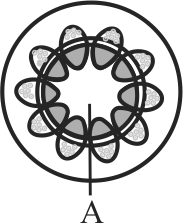334040
Statement A :
In dicot stems, the cells of cambium present between primary xylem and primary phloem is the intrafascicular cambium.
Statement B :
The cells of medullary rays, adjoining these intrafascicular cambium become meristematic and form the interfascicular cambium.
334040
Statement A :
In dicot stems, the cells of cambium present between primary xylem and primary phloem is the intrafascicular cambium.
Statement B :
The cells of medullary rays, adjoining these intrafascicular cambium become meristematic and form the interfascicular cambium.
334040
Statement A :
In dicot stems, the cells of cambium present between primary xylem and primary phloem is the intrafascicular cambium.
Statement B :
The cells of medullary rays, adjoining these intrafascicular cambium become meristematic and form the interfascicular cambium.
334040
Statement A :
In dicot stems, the cells of cambium present between primary xylem and primary phloem is the intrafascicular cambium.
Statement B :
The cells of medullary rays, adjoining these intrafascicular cambium become meristematic and form the interfascicular cambium.
334040
Statement A :
In dicot stems, the cells of cambium present between primary xylem and primary phloem is the intrafascicular cambium.
Statement B :
The cells of medullary rays, adjoining these intrafascicular cambium become meristematic and form the interfascicular cambium.

